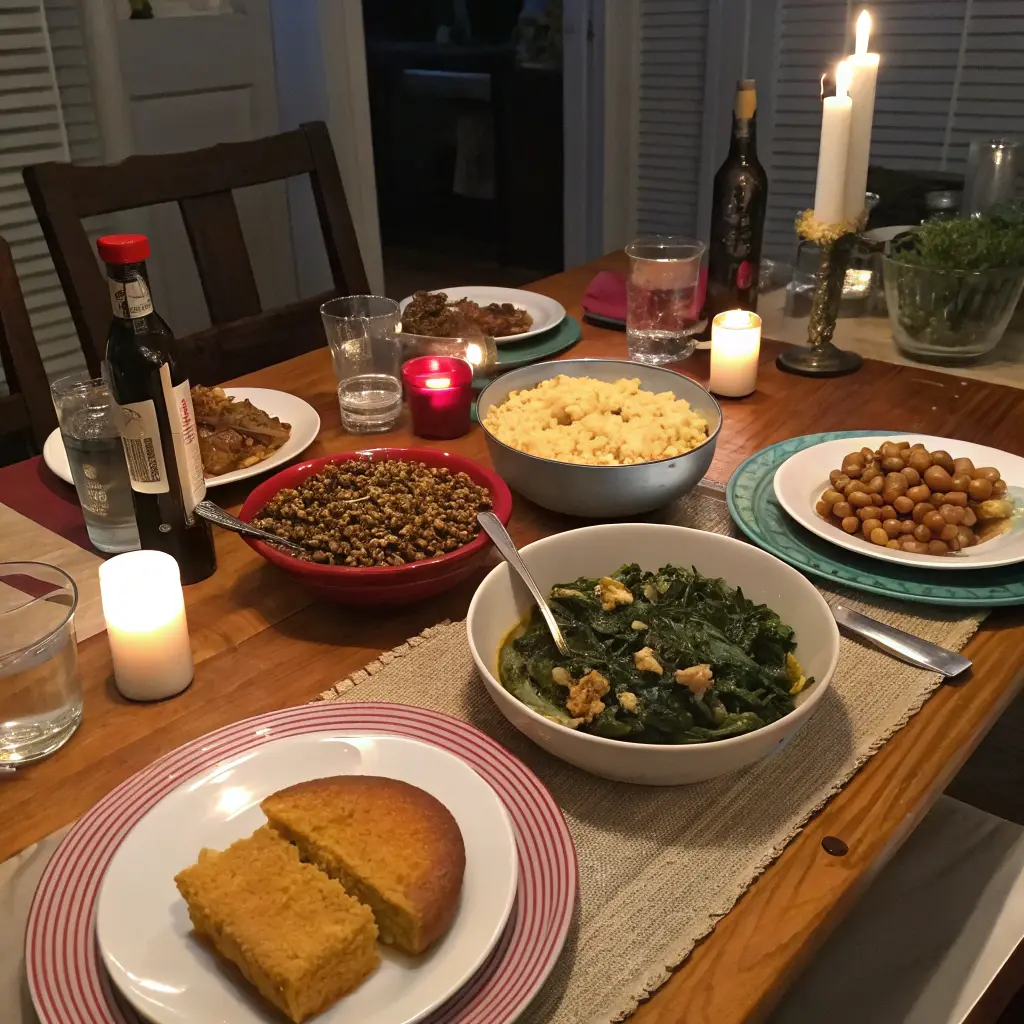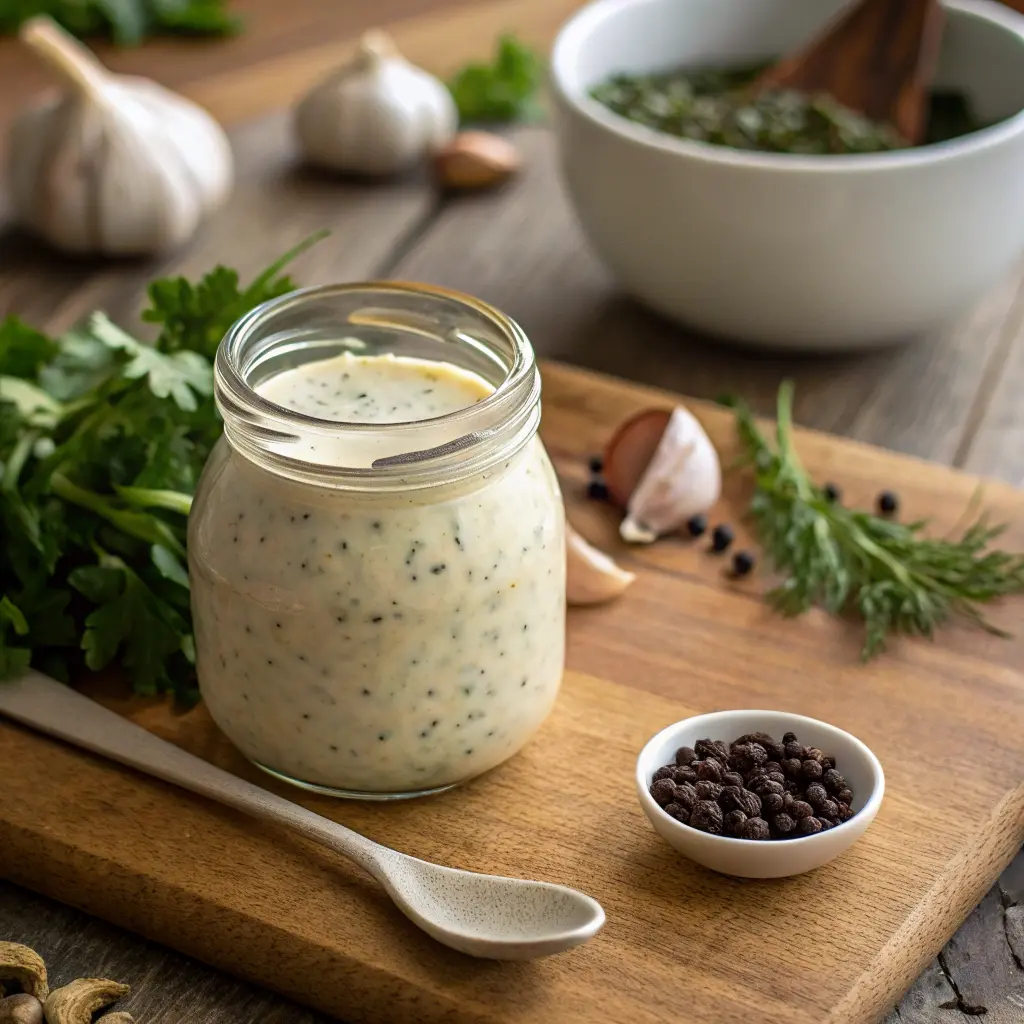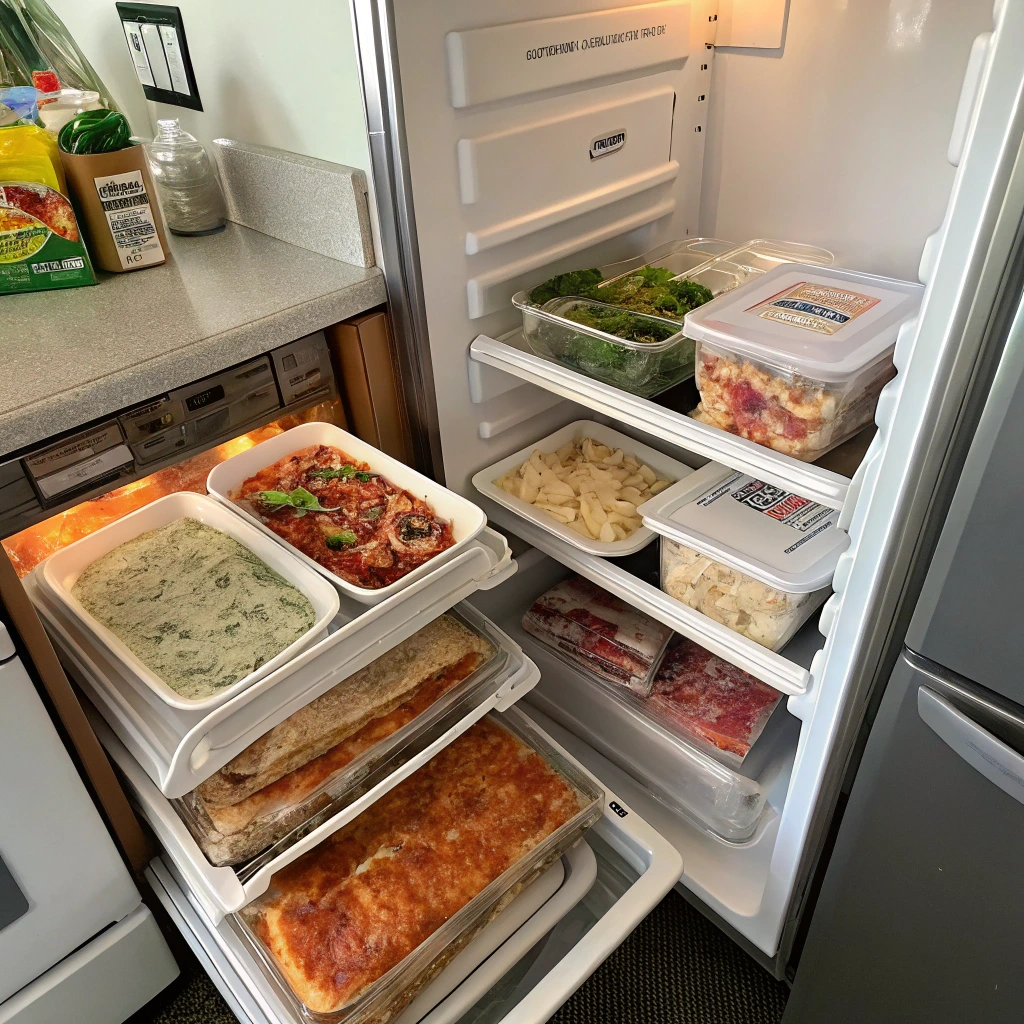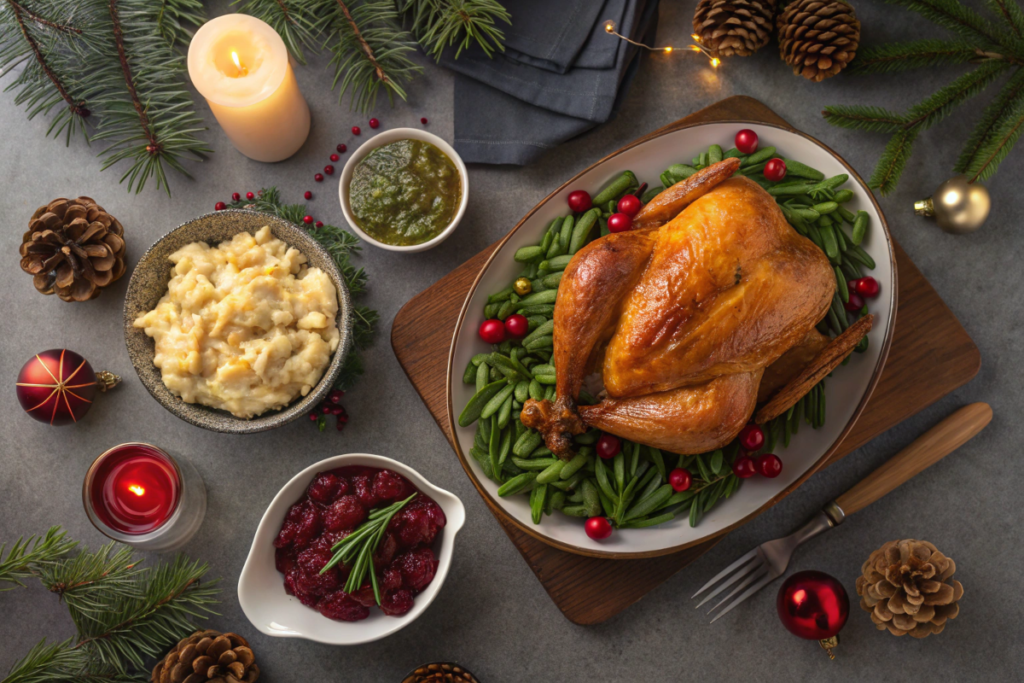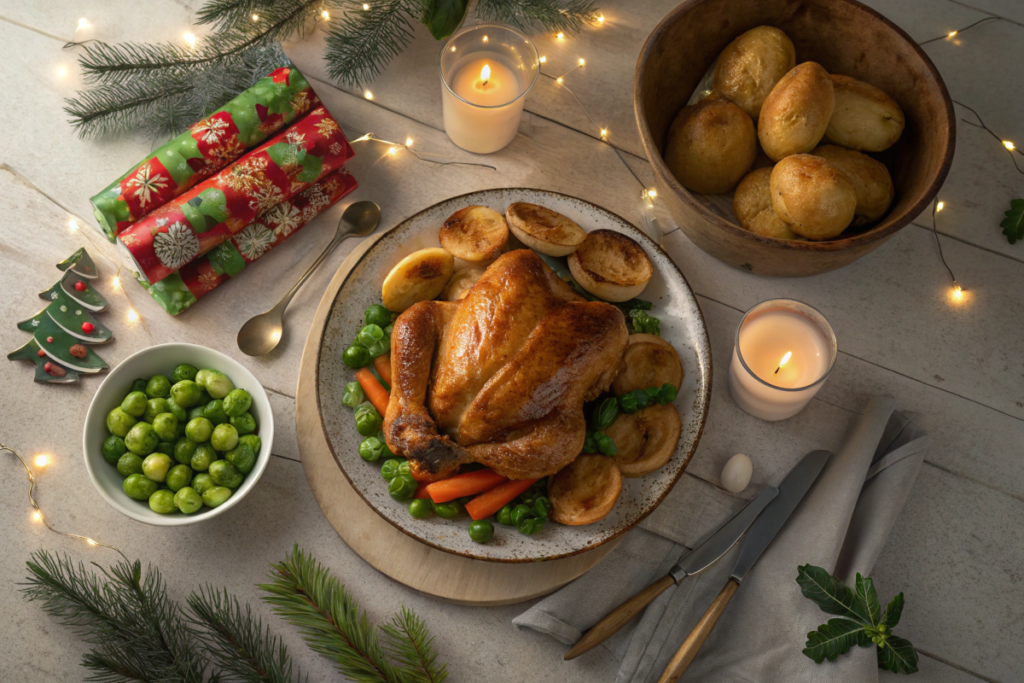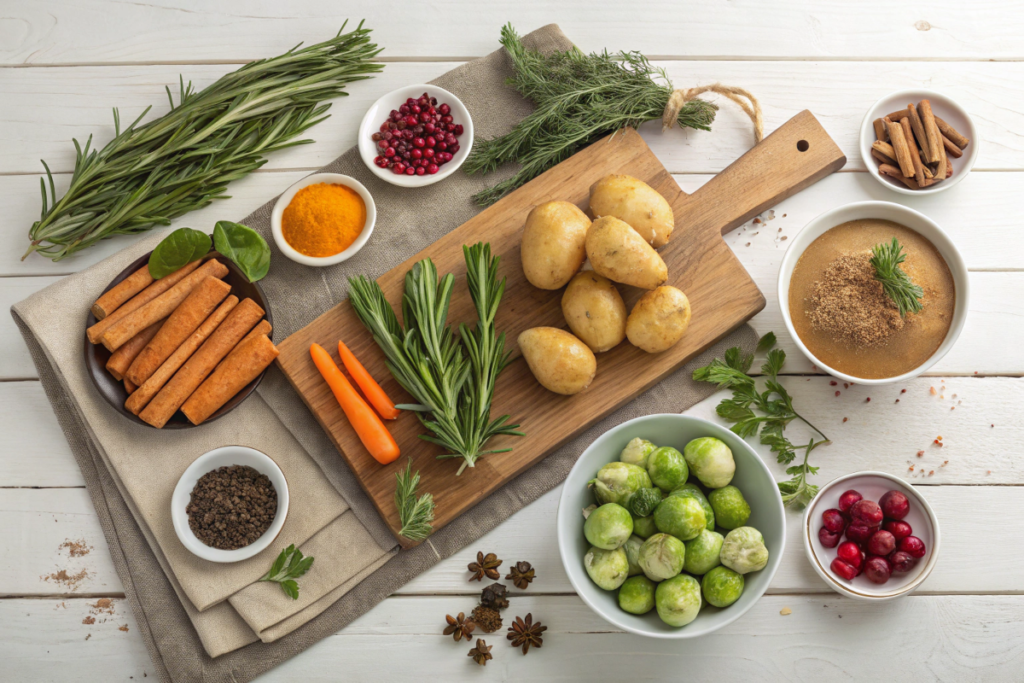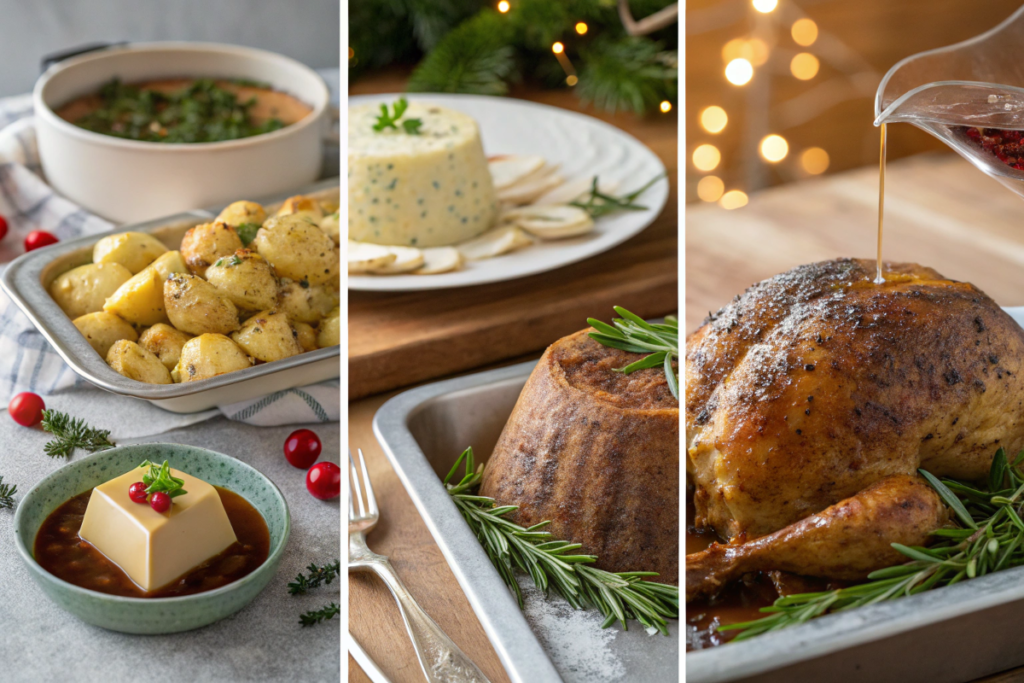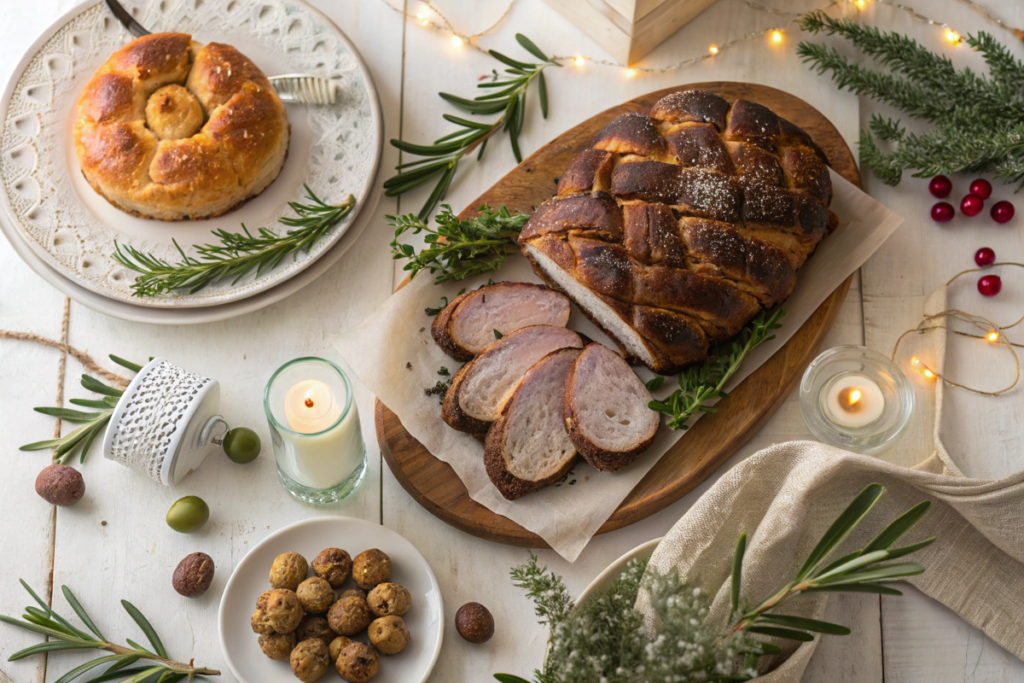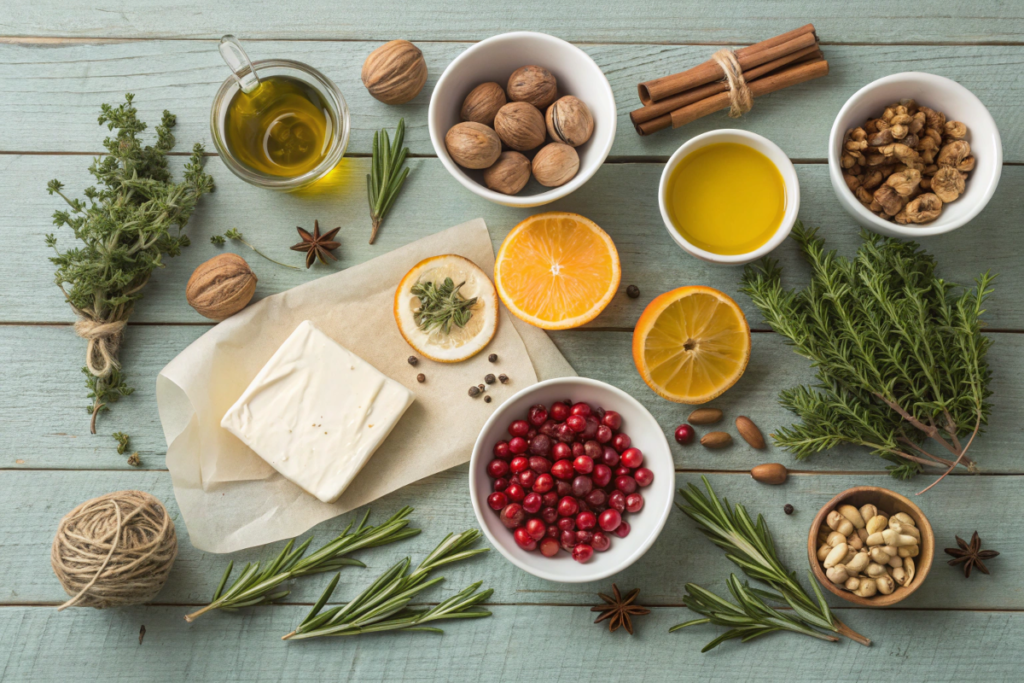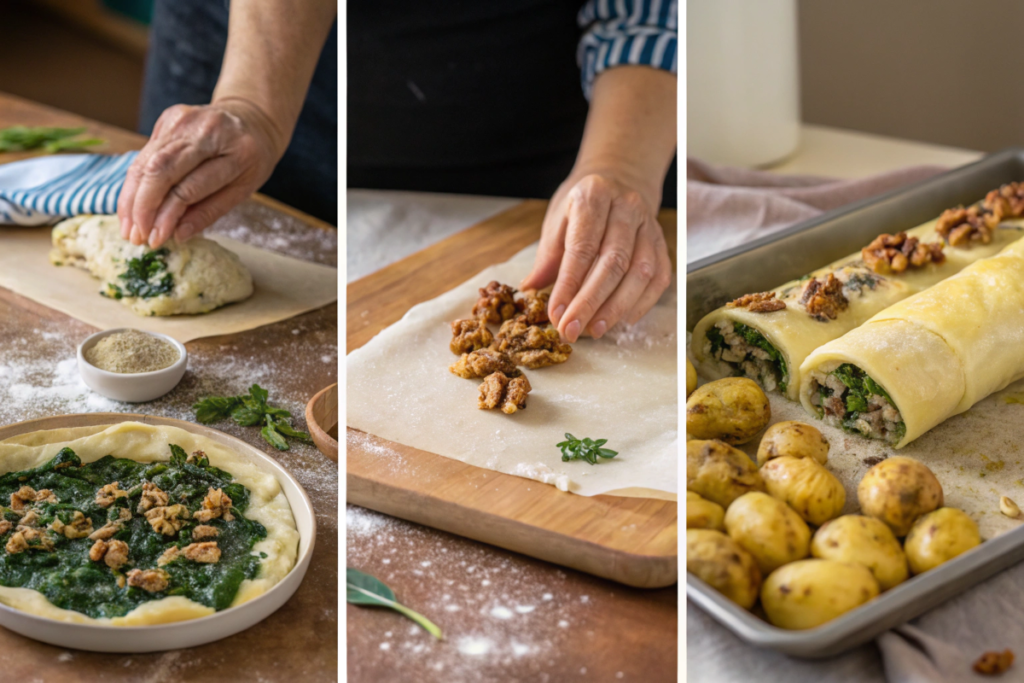Many people wonder, “What is a traditional Christmas dinner menu?”, especially when they see pictures of roast meats, festive pies, and decadent desserts on social media. Indeed, a Classic Christmas feast often brings together family favorites, timeless appetizers, and sweet treats that complete the holiday spirit. If you’d like more insight into the traditions surrounding an English holiday spread, take a look at this detailed guide.
Furthermore, each course reflects longstanding customs, warm hospitality, and seasonal flavors cherished in many cultures worldwide. Although different regions have unique dishes, most Christmas dinners share a few common themes: hearty main courses, comforting sides, mouthwatering desserts, and festive beverages that add sparkle to the occasion.
The Origins of the Traditional Christmas Dinner
Historical Evolution of Christmas Feasts
To understand the Festive dinner recipes that shape a modern Christmas table, it helps to trace holiday meals back through history. Initially, medieval feasts provided plentiful courses, including roasted game and sweetmeats, for nobles and their guests.
Eventually, these grand banquets inspired home cooks to create scaled-down versions for their families. Indeed, people from the Middle Ages embraced roasted meats alongside spiced ales, forming the earliest hints of a Classic Christmas feast. Over time, explorers introduced new ingredients, such as potatoes from the Americas, which soon became staples.
Regional Variations in Christmas Dinner Traditions
Different countries bring their own flair to the holiday table. For instance, Italians often serve multiple seafood dishes on Christmas Eve, while Germans treasure stollen bread and roasted goose for the main day. Similarly, British households emphasize roast turkey and plum pudding, and Americans might prepare honey-baked ham or green bean casserole.
Therefore, a Traditional Christmas dinner menu depends partly on family heritage and local customs. Consequently, flavors change from region to region, yet the underlying celebration remains the same: sharing delicious, Festive dinner recipes with those we love.
Cultural Significance of Christmas Foods
Throughout history, people assigned symbolic meaning to certain ingredients or cooking methods. For example, the shape of a wreath-like bread might represent unity, while certain spices—like cinnamon—signify warmth and good fortune. Indeed, these culinary symbols transcend borders, appearing in multiple countries under different guises.
Meanwhile, preserving these icons in a Classic Christmas feast has helped keep cultural heritage alive. By passing down recipes from one generation to the next, families reinforce the spiritual and communal values that holidays represent.
Common Appetizers in a Traditional Christmas Dinner
Classic Soups and Salads
Often, the first course in a Traditional holiday meal includes a comforting soup or fresh salad. Although menu choices vary by region, many households opt for butternut squash soup, creamy mushroom soup, or hearty vegetable chowder. Indeed, these warm bowls set a cozy tone for the rest of the feast.
Moreover, salads laced with dried cranberries, pecans, or blue cheese add both color and zest to your Christmas dinner menu. Because these courses are light, they leave room for larger entrees and heavier sides later on.
Traditional Hors d’Oeuvres
Hors d’oeuvres often appear alongside soups and salads, providing tasty bites that guests can enjoy as they mingle. In fact, miniature quiches, stuffed mushrooms, and bacon-wrapped dates frequently earn praise for their blend of savory and sweet flavors. Meanwhile, deviled eggs, smoked salmon canapés, or brie en croûte add an elegant touch.
Sometimes, these small plates also reflect cultural twists, like pairing hot peppers with cheese for a bit of spice. Ultimately, well-chosen hors d’oeuvres enrich a Traditional Christmas dinner menu and allow guests to snack without feeling too full before the main course.
Main Dishes that Define a Christmas Feast
Roasted Turkey: The Star of the Show
When people imagine a Classic Christmas feast, roast turkey often comes to mind. Indeed, turkey’s mild yet flavorful meat provides a neutral canvas for savory rubs and stuffing, making it ideal for a traditional holiday meal.
Moreover, roasting a turkey to perfection reveals crisp skin, juicy slices, and an aroma that fills the entire house. To achieve consistent results, many cooks brine the bird overnight and baste it with herb butter. Meanwhile, a pan gravy prepared from the drippings heightens that homey feeling we crave at Christmas.
Additionally, timing remains crucial for ensuring the turkey cooks evenly. By using a meat thermometer, you can confirm the internal temperature hits about 165°F (74°C).
Consequently, guests will enjoy moist, tender portions every time. Although other entrees exist, roast turkey continues to symbolize the heart of a Traditional Christmas dinner menu for many families across North America and beyond.
Alternatives to Turkey: Ham, Goose, and Beef
Despite turkey’s popularity, some households opt for ham, goose, or beef as their main dish. Because spiral-cut ham can be glazed with brown sugar or pineapple, it adds a sweet-savory contrast that complements classic sides.
Similarly, goose once reigned supreme in Victorian Christmas feasts, offering rich, gamey flavors well-suited to festive gatherings.
Meanwhile, prime rib or beef tenderloin brings a luxurious twist, especially when served with au jus or Yorkshire puddings.
Certainly, these alternatives expand your Festive dinner recipes for guests who prefer something different from poultry.
Thus, picking a centerpiece often hinges on personal taste, family tradition, or dietary needs. Nevertheless, each of these meats can anchor a sumptuous holiday table if prepared with care. By diversifying the main course, you introduce variety while still honoring the spirit of a traditional holiday meal.
Vegetarian and Vegan Options for the Main Course
An inclusive Christmas dinner menu accounts for guests who prefer plant-based fare. Indeed, elaborate vegetable wellingtons, stuffed squash, or lentil roasts can stand in for meat.
Moreover, homemade nut roasts often surprise carnivores with their hearty textures and umami-rich flavors. Because modern cooking embraces a wealth of ingredients, building a vegetarian main dish doesn’t mean sacrificing taste or creativity. Likewise, vegan gravies, mashed potatoes with plant-based butter, and dairy-free sauces ensure everyone feels welcome at your table.
Additionally, featuring a well-crafted vegetarian dish can shine as an equal to turkey or ham. Meanwhile, your table gains colorful variety, pleasing the eye as well as the palate. Ultimately, offering plant-based entrees aligns with changing culinary trends, ensuring your Classic Christmas feast resonates with modern sensibilities.
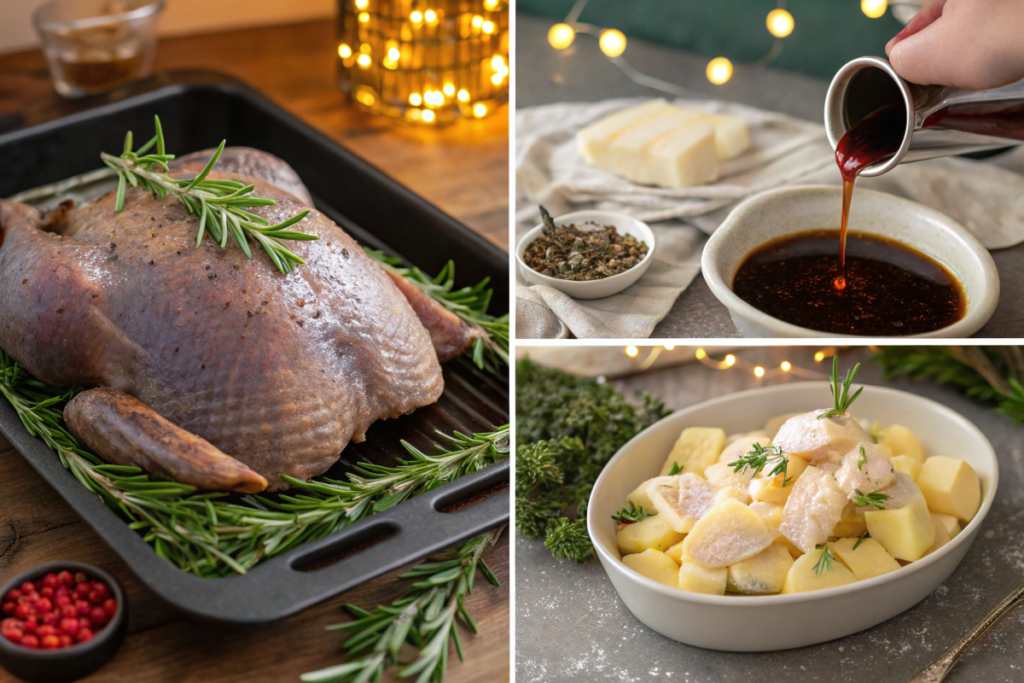
Traditional Side Dishes to Complement the Meal
Stuffing and Dressing Variations
No traditional holiday meal is complete without stuffing or dressing. Though definitions vary by region, stuffing often goes inside the bird, while dressing bakes separately. In fact, both methods can yield moist, flavorful bites.
Many recipes feature a bread base infused with onions, celery, herbs, and sometimes sausage or fruit.Meanwhile, cornbread dressing remains popular in parts of the American South, adding a crumbly texture and slightly sweet note.
Moreover, you might incorporate cranberries, apricots, or nuts for extra depth. This side dish deftly bridges the savory main course with tangy or sweet accents, tying the flavors of your Christmas dinner menu together.
Mashed Potatoes and Gravy
Mashed potatoes and gravy often define a Classic Christmas feast, offering creamy comfort that pairs beautifully with roasted meats. Because potatoes are mild, they allow the richness of gravy to shine. Meanwhile, adding roasted garlic or cheddar cheese can elevate basic mashed potatoes into a gourmet treat.
Additionally, smooth gravy, made from pan drippings or stock, imparts a savory element that ties all parts of the meal together.
Indeed, many guests anticipate ladling gravy over not just potatoes but turkey slices and stuffing too.
Festive Vegetables: Green Beans, Brussels Sprouts, and More
Hearty vegetables complete your Festive dinner recipes, ensuring guests get a balanced plate.
Often, cooks blanch green beans, then sauté them with garlic or almonds for a colorful side.
Furthermore, roasted Brussels sprouts—tossed in olive oil and balsamic vinegar—offer a caramelized, slightly sweet crunch.
In some regions, glazed carrots or sweet potatoes appear, adding bright orange hues to the table. Because vegetables add color and essential nutrients, they complement the heavier components of a Traditional Christmas dinner menu.
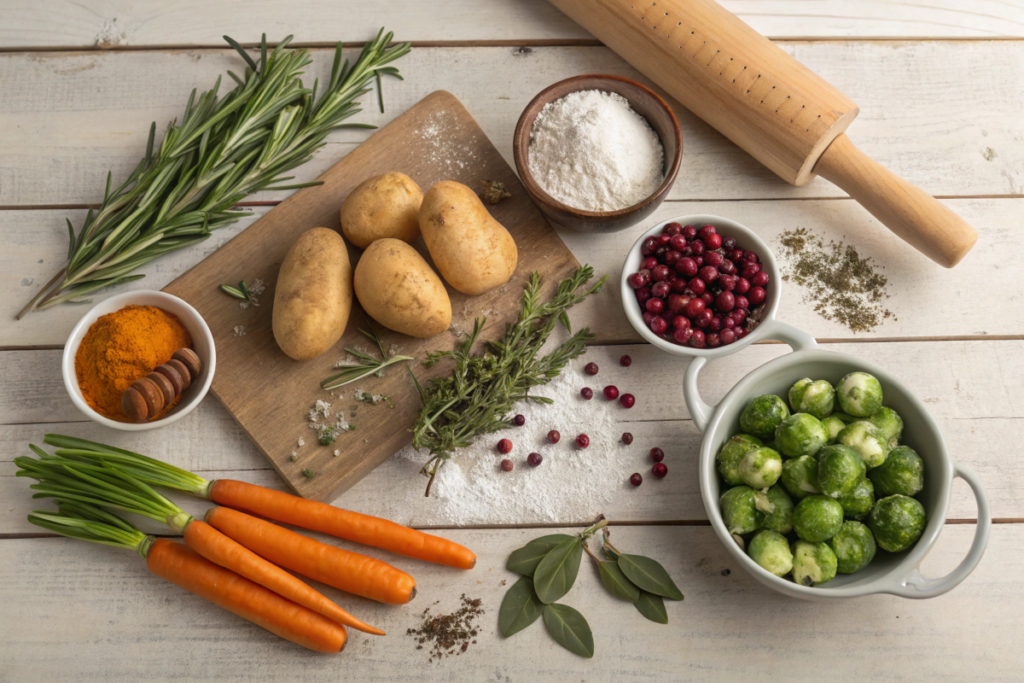
Iconic Christmas Desserts
Christmas Pudding: A Timeless Treat
Christmas pudding remains a central dessert in many English-speaking countries, standing as a symbol of traditional holiday meal finales.
Often steamed for hours, this dense, fruit-laden pudding features dried currants, raisins, and sometimes brandy.
Furthermore, families might hide a coin or trinket inside for good luck. Meanwhile, serving it flaming with brandy or rum sauce impresses guests and underscores the magical atmosphere.
Certainly, this iconic dessert’s centuries-long history makes it a favorite in classic celebrations.
Yule Log Cake and Other Popular Desserts
Beyond pudding, some households turn to a Yule Log cake for sweet delight. Commonly made of rolled sponge cake filled with cream, this treat resembles a wooden log dusted with powdered sugar to simulate snow.
Indeed, the Yule Log both tastes delicious and doubles as a festive centerpiece. Additionally, cookies, pies, and trifles appear in many homes, reflecting local preferences and bridging tradition with modern flair.
Offering various desserts, from cookies to pies, ensures every sweet tooth finds contentment in a Christmas dinner menu.
Regional Dessert Variations Around the World
Interestingly, global traditions yield countless dessert options for a Classic Christmas feast.
For instance, panettone in Italy, stollen in Germany, and pavlova in Australia highlight the culinary diversity that Christmas fosters.
Meanwhile, Latin American families might enjoy dulce de leche confections or fried buñuelos sprinkled with cinnamon sugar.
Indeed, these desserts reflect each culture’s climate, produce, and heritage, reminding us that a traditional holiday meal can take many shapes while uniting friends and families through sweetness.
Traditional Beverages Served with Christmas Dinner
Mulled Wine and Eggnog
Often, mulled wine exudes the warm, spiced aroma that evokes a Festive dinner recipes ambiance. Infused with cloves, cinnamon, and citrus, mulled wine brings a cozy feel to the table.
Meanwhile, eggnog, thickened with eggs and cream, offers a creamy beverage that pairs well with cookies or dessert. Because both drinks act as holiday staples, they stand among the most popular ways to spread cheer at a traditional holiday meal.
Indeed, the smell of mulling spices alone can make a room feel more welcoming during the cold winter months.
Non-Alcoholic Festive Drinks
Nevertheless, not everyone partakes in alcohol, so offering non-alcoholic options ensures inclusivity. For instance, warm apple cider or spiced hot chocolate can comfort guests who avoid or limit alcohol.
Additionally, fruit punches, infused waters, or cranberry spritzers provide refreshing alternatives that still capture the flavor of the season.
Moreover, these beverages align with the same spirit that guides a Classic Christmas feast: bringing people of all ages together to celebrate.
Setting the Table for a Traditional Christmas Dinner
Table Decorations and Centerpieces
Decorating the table contributes to the holiday mood of a Christmas dinner menu. Sometimes, a bold centerpiece with fresh flowers, evergreens, or candles becomes a focal point.
Indeed, choosing color themes such as red, green, or gold ties the design to the Christmas concept. Meanwhile, smaller decorative accents—like place card holders or themed napkin rings—help unify the visual presentation.
Because the eye first notices overall aesthetics, these finishing touches can shape the guest experience long before the first bite.
Cutlery and Serving Traditions
Proper cutlery placement matters for many hosts, reflecting a sense of formality in a traditional holiday meal. Placing forks on the left, knives on the right, and spoons next to knives simplifies the diner’s experience.
Furthermore, large platters or serving dishes often grace the center of the table, encouraging a “family-style” approach.
Indeed, passing bowls around fosters conversation and keeps guests engaged. Interestingly, some families prefer a buffet-style service, giving each person freedom to select their own portions.
Regardless of the approach, the goal remains the same: to enhance the Classic Christmas feast atmosphere.
Regional Variations in Christmas Dinner Menus
European Christmas Dinner Traditions
In Europe, national differences create a kaleidoscope of festive customs. For example, French families may indulge in foie gras and bûche de Noël, while Spaniards often savor seafood-centric feasts on Christmas Eve.
Meanwhile, Germans focus on roasted goose or duck, along with spiced Lebkuchen cookies.
Clearly, these variations speak to the abundance of local produce and heritage. Although each country’s spread differs, all revolve around a Classic Christmas feast that values togetherness, flavor, and tradition.
American and Canadian Festive Menus
North Americans generally center their Christmas dinner menu on turkey, ham, or roast beef, along with an array of side dishes like green bean casserole and sweet potato casserole.
Indeed, the “ugly sweater” phenomenon, along with eggnog and candy canes, underscores the fun, informal spirit in these regions. Meanwhile, Canadians might incorporate French-Canadian meat pie (tourtière) for an extra dash of authenticity.
Overall, these multi-cultural celebrations capture the diversity of holiday customs throughout North America.
Christmas Foods from Asia, Africa, and Australia
Elsewhere, families adapt Christmas meals to local climates and food availability. In Asia, certain Christian communities favor roasted duck or local fish, served with spicy condiments.
Additionally, coconut-based sweets or steamed rice cakes can appear alongside more Western-style roasts. Meanwhile, in Africa, grilled meats and stews might accompany jollof rice or fufu, blending local flavors with symbolic Christian references.
Consequently, these regional fusions remind us how Festive dinner recipes evolve to suit each environment. Finally, Australians often plan barbecue picnics or beach gatherings due to warm December weather, proving that a traditional holiday meal can be enjoyed even in a summery setting.
FAQs About Traditional Christmas Dinner Menu
What are some make-ahead Christmas dinner recipes?
You can prepare casseroles, soups, and baked stuffing a day in advance.
Pre-chopped veggies and sauces also speed up your Festive dinner recipes on the big day.
What is the best wine to pair with Christmas dinner?
Many choose a full-bodied red wine (like Cabernet Sauvignon) for roast meats or a crisp white wine (like Chardonnay) for lighter dishes.
Match the wine to your Classic Christmas feast flavors.
Are there gluten-free or dairy-free Christmas dinner options?
Yes. Swap wheat flour for gluten-free alternatives in stuffing or gravy, and use dairy-free milk in mashed potatoes.
These easy changes keep your Christmas dinner menu inclusive without sacrificing taste.
Conclusion
A Traditional Christmas dinner menu bridges history and modern tastes to create a memorable holiday meal. With hearty main dishes, comforting sides, and festive desserts, each course brings warmth and cheer to the holiday table.

